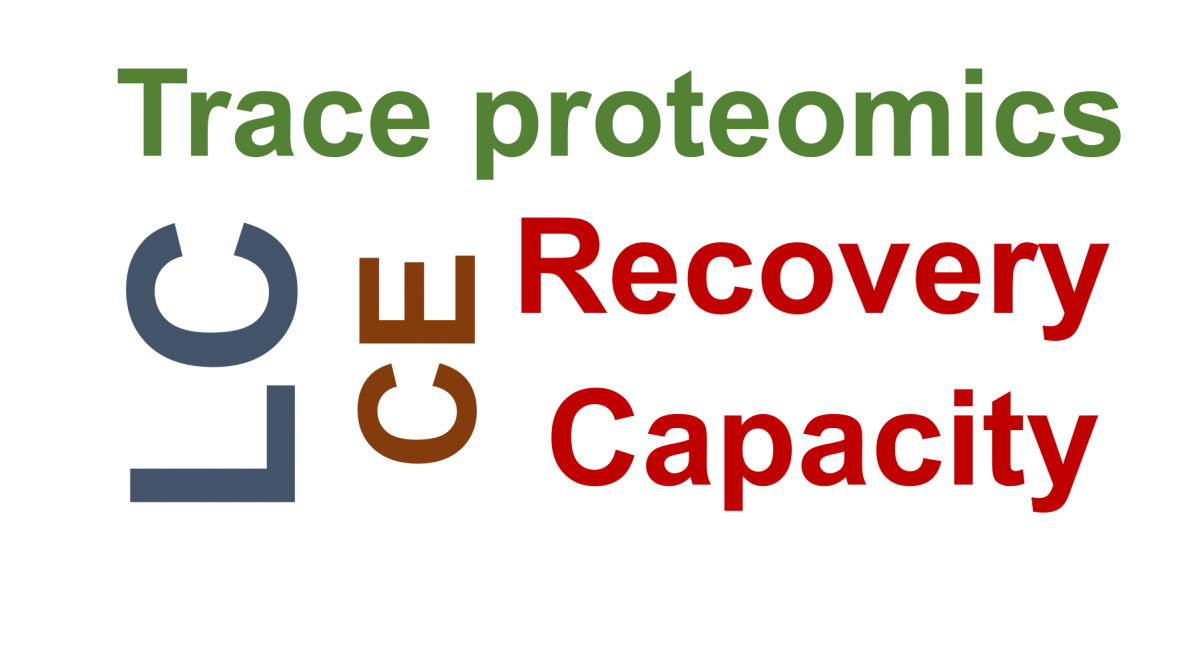Please note that authorship is reserved, and you must have my consent before reproducing this article.
Technology has been a main driven power prompting development of system biology study. In the acquisition of proteomic digital data, a separation method in conjugation with tandem mass spectrometry is an optimal combination given that mass spectrometry cannot handle thousands of peptides flowing inside at the same time. The following content presents a mini-review for several separation methods that are of the author’s interest, targeting trace proteomics.
Two factors contribute heavily to the performance of LC-based trace proteomics:
- Sample loss in separation system.
- Separation capacity. It affects the attainable proteome measurement coverage due to the high complexity of typical proteomic samples and the very different relative abundances of their components.
The major effort resolves to ensure enough separation, due to its necessity to separate peptide complex with huge difference in dynamic range, especially those low abundance peptides close to detection level, tending to be interference. and ensure enough proteome coverage. Also, a good separation allows for a lower flow rate and hence improved ionization efficiency.
The frontier credit goes to Shen et al1. At year 2004, they applied a ∼20 nL/min mobile-phase flow rate to separate peptide samples, achieved with on-line couplization with microSPE, and applying a very small i.d. LC column (15 um). This allows a separation peak capacity of ∼1000 for LC gradient of 2-3 hours, herein enabling samples per minute entering ESI to be very low, to achieve higher ionization efficiency. In reality, as low as 75 zmol BSA tryptic digest were tested, leading to an estimated peptide mass detection limit of 10 zmol (i.e., ∼6000 molecules) and a peptide concentration detection limit of ∼250 aM, which means that a theoretical identification from 0.5 pg sample is feasible. Similar works applying lower flow rate (~10 nL/min) and thinner capillary (10-µm-i.d.) was optimized and reported2. Yusuke et al considered conventional packing materials of LC columns, C18, as inappropriate in trace sample analysis3. As a typical porous particle, C18 helps in increasing peptide loading capacity, which is not necessary when sample input is minimal. Oppositely, sample loss could be reflected during loading, and pores also introduces severe diffusion, causing low separation power. Nonporous C30 particles only binds peptides to the surface, and maypotentially alleviate the problem. The in-house packed 150 mm × 75 μm C30 column brings extra peptide identification in 10-100 ng HEK293F cell tryptic digest peptides, and for same peptides brings to higher peaks, hence higher validity. The longer the gradient tends to bring higher identification. As the effect of peak interference could be minimized. At cell level, over 1,400 proteins were identified from 100 HEK293F cells, benefiting from the non-porous column using 2 hr gradient, validating the possibility of popularized use. In a separate study, the same research group also found lowering flow rate beneficial to trace proteomic study 4, and managed to identify 19,000 peptides and ~2700 proteins from as low as 10ng peptides with flow rate of 100 nL/min, half fold increase than with 300 nL/min. μPAC from PharmaFluidics, a micropillar array-based nano-HPLC cartridge, is advantageous in the inherent high permeability and low ‘on-column’ dispersion, and ergo in a 10 ng HeLa tryptic dirgest benchmarking study achieved almost twice as many unique peptide and unique protein group identifications comparing with converntional nanoLC columns, with the strength stressed as the gradient increases 5. It’s worth noting that retention time stability and precision are also assured with a good peak separation. Researchers applied poly(styrene−divinylbenzene) (PS−DVB), 10-μm-i.d. porous layer open tubular (PLOT) capillary columns to reduce chromatographic band dilution and at higher concentration elute the analytes, while maintaining the high loading capacity. Elaborate preprartion of the column could achieve a high and reproducible surface area and phase ratio. IN conjugation with ultra-low mobile phase flow rates, could hence allow low attomole- to zeptomole- detection sensitivity6,7.
An alternative of liquid chromatography is capillary electrophoresis (CE), and has been acknowledged in high separation power, fast separation and remarkable limits of detection with its good conjugation with coaxial sheath-flow ESI8. Nemerous studies have shown the feasibility of analyzing trace peptide samples, detailedly reviewed in specific publications8,9. To name a few, Peter Nemes’s group has been optimizing on specific sheath-flow CE-ESI interfaces to trace proteomic application, and so far have completed a theoretical sensityivity of 1 pg BSA protein detection. CE with its product variants have been applied to analyzing 10 ng Xenopus laevis embryo protein digest10 and 1 ng mouse cortex protein digest8 proteome successively, showing the great potential of this flourishing technology.
References
(1) Shen, Y.; Tolić, N.; Masselon, C.; Paša-Tolić, L.; Camp, D. G.; Hixson, K. K.; Zhao, R.; Anderson, G. A.; Smith, R. D. Analytical Chemistry 2004, 76, 144-154.
(2) Luo, Q.; Tang, K.; Yang, F.; Elias, A.; Shen, Y.; Moore, R. J.; Zhao, R.; Hixson, K. K.; Rossie, S. S.; Smith, R. D. Journal of Proteome Research 2006, 5, 1091-1097.
(3) Kawashima, Y.; Ohara, O. Analytical Chemistry 2018, 90, 12334-12338.
(4) Kawashima, Y.; Watanabe, E.; Umeyama, T.; Nakajima, D.; Hattori, M.; Honda, K.; Ohara, O. Int J Mol Sci 2019, 20.
(5) Stadlmann, J.; Hudecz, O.; Krššáková, G.; Ctortecka, C.; Van Raemdonck, G.; Op De Beeck, J.; Desmet, G.; Penninger, J. M.; Jacobs, P.; Mechtler, K. Analytical Chemistry 2019, 91, 14203-14207.
(6) Li, S.; Plouffe, B. D.; Belov, A. M.; Ray, S.; Wang, X.; Murthy, S. K.; Karger, B. L.; Ivanov, A. R. Molecular & Cellular Proteomics 2015, 14, 1672.
(7) Yue, G.; Luo, Q.; Zhang, J.; Wu, S.-L.; Karger, B. L. Analytical Chemistry 2007, 79, 938-946.
(8) Choi, S. B.; Zamarbide, M.; Manzini, M. C.; Nemes, P. Journal of The American Society for Mass Spectrometry 2017, 28, 597-607.
(9) Bonvin, G.; Schappler, J.; Rudaz, S. Journal of Chromatography A 2012, 1267, 17-31.
(10) Lombard-Banek, C.; Moody, S. A.; Nemes, P. Angewandte Chemie International Edition 2016, 55, 2454-2458.
